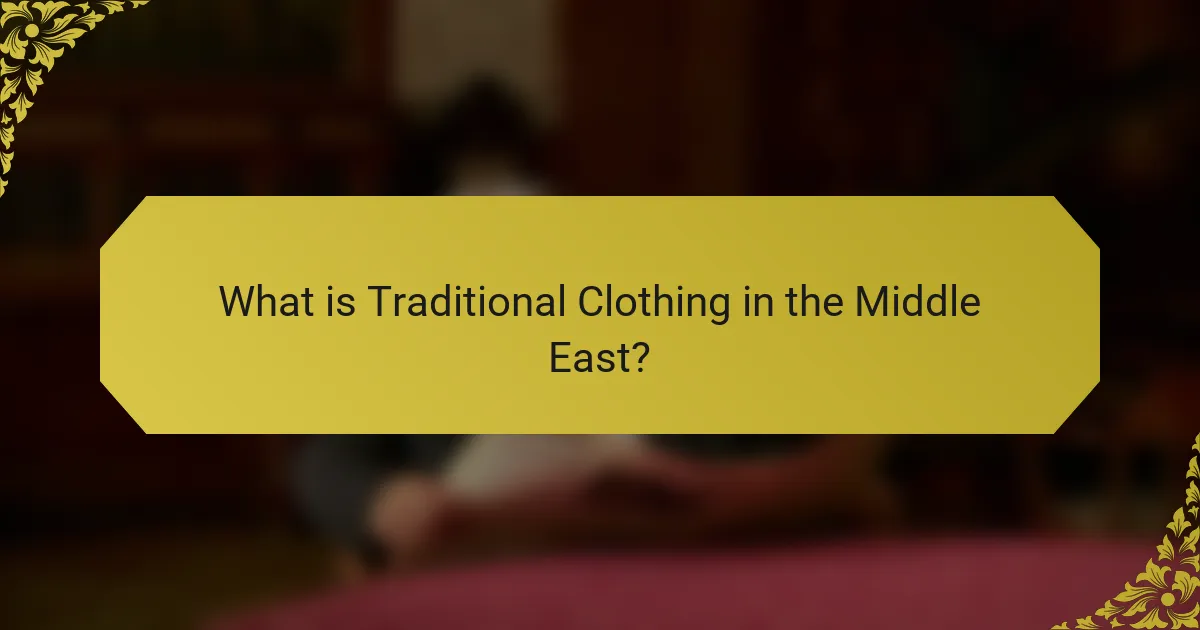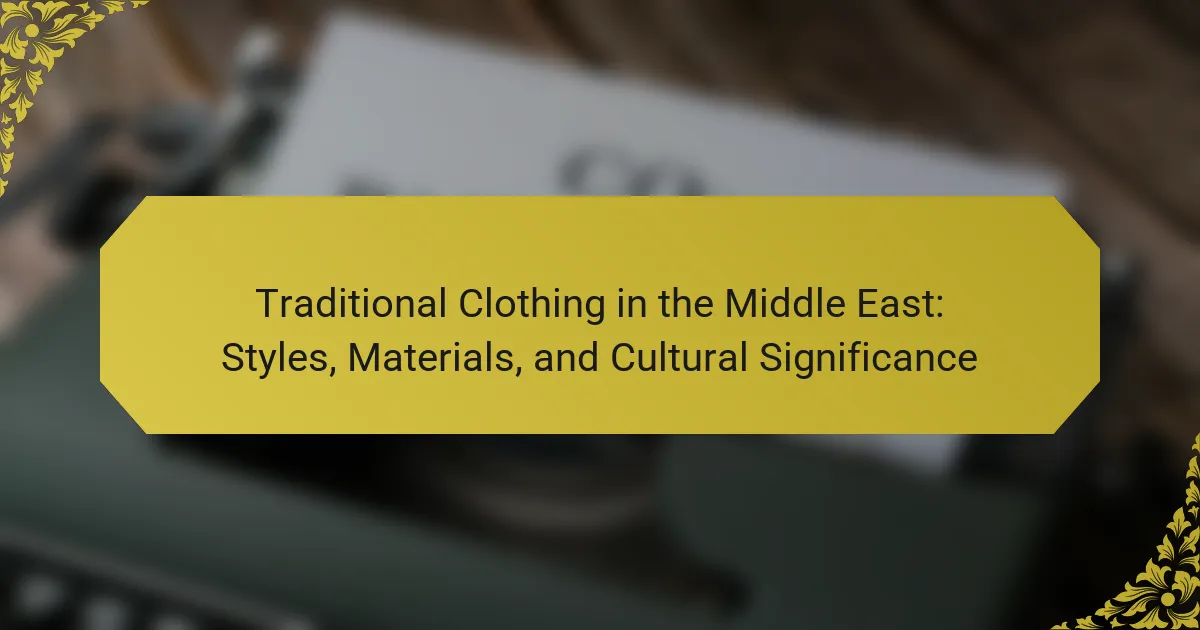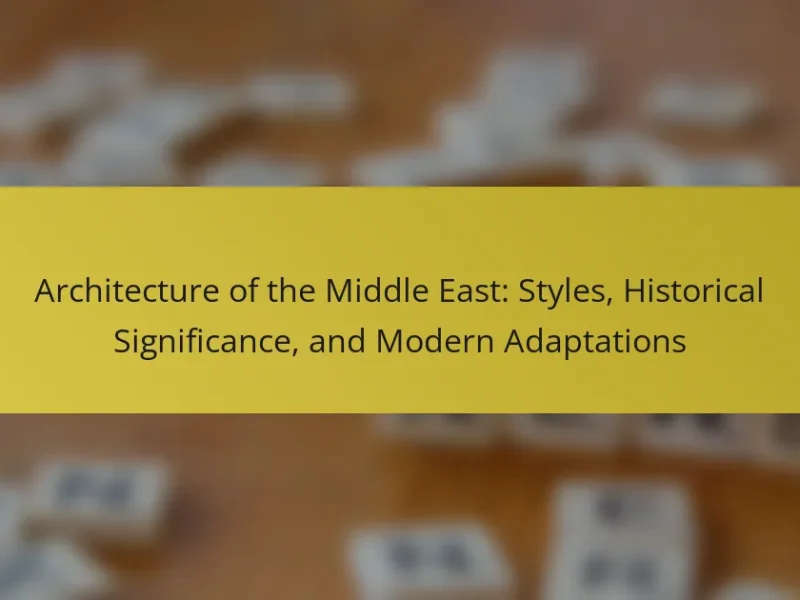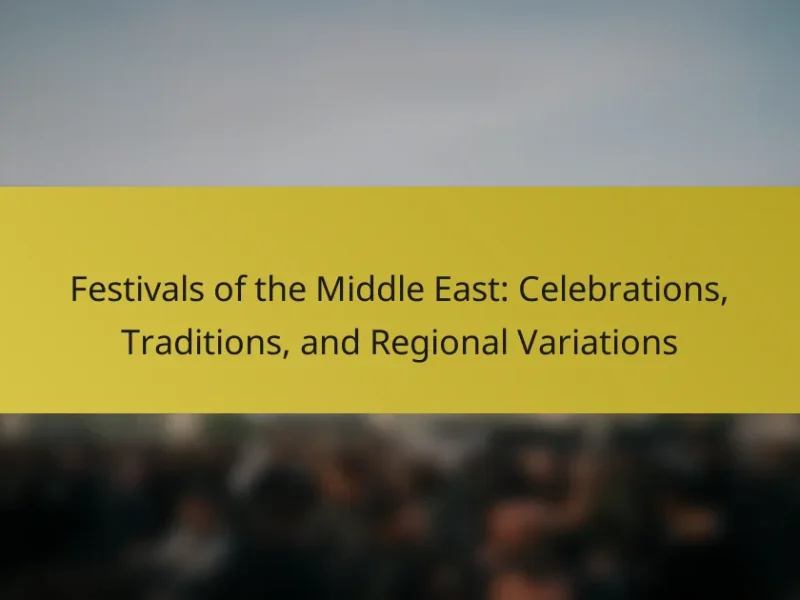
What is Traditional Clothing in the Middle East?
Traditional clothing in the Middle East refers to the garments worn by people in this region, reflecting cultural heritage and identity. Common traditional attire includes the abaya for women and the thobe for men. The abaya is a long, flowing robe, often black, worn over other clothing. The thobe is a long tunic, typically white, worn with a headscarf called a keffiyeh or ghutrah. Materials for these garments often include cotton and silk, suitable for the hot climate. Traditional clothing varies by country, with specific styles and colors representing different cultures. The cultural significance of these garments lies in their representation of social status, regional identity, and adherence to cultural norms.
How does Traditional Clothing reflect cultural identity?
Traditional clothing reflects cultural identity by embodying the values, beliefs, and history of a community. It serves as a visual representation of cultural heritage. Specific styles, colors, and patterns often signify regional origins and social status. For example, the keffiyeh is a symbol of Palestinian identity. Traditional garments can also indicate religious affiliations, such as the hijab in Islamic cultures. Moreover, clothing often incorporates local materials and craftsmanship, showcasing regional resources and skills. Historical events have influenced clothing styles, preserving stories and traditions across generations. Thus, traditional clothing is an essential element in the expression of cultural identity.
What are the historical influences on Traditional Clothing in the Middle East?
Traditional clothing in the Middle East is influenced by various historical factors. The region’s climate has shaped clothing styles, promoting loose and breathable fabrics. Cultural exchanges through trade routes introduced diverse textiles and designs. Historical empires, such as the Ottoman and Persian, impacted clothing styles through their vast reach and cultural integration. Religious beliefs also played a significant role, dictating modesty and specific attire. Local customs and traditions further influenced clothing, leading to regional variations. Historical events, including colonization and globalization, have also shaped modern interpretations of traditional attire. Each of these influences contributes to the rich tapestry of Middle Eastern traditional clothing.
How do regional variations impact Traditional Clothing styles?
Regional variations significantly impact traditional clothing styles by influencing fabric choices, designs, and cultural symbolism. In the Middle East, diverse climates dictate the materials used, such as lightweight fabrics in hotter regions and heavier textiles in cooler areas. Different ethnic groups contribute unique patterns and styles, reflecting their cultural heritage. For example, the Bedouin utilize specific embroidery techniques that signify tribal identity. Additionally, religious practices shape clothing styles, with variations in modesty requirements across regions. Historical trade routes also introduce external influences, leading to hybrid styles. Thus, regional variations create a rich tapestry of traditional clothing that embodies local customs and identities.
What are the different styles of Traditional Clothing in the Middle East?
Traditional clothing in the Middle East includes various styles that reflect cultural heritage. Common styles are the abaya, a loose-fitting robe worn by women, and the thobe, a long garment worn by men. The kaftan is another popular style, often elaborately designed for both genders. In specific regions, such as the Gulf states, men may wear a dishdasha. Women in rural areas might wear colorful embroidered dresses known as the jarab. Each style serves not only aesthetic purposes but also signifies social status and cultural identity. Traditional clothing often incorporates regional fabrics, colors, and patterns.
What are the key characteristics of men’s Traditional Clothing?
Men’s traditional clothing in the Middle East is characterized by cultural significance, distinct styles, and specific materials. These garments often reflect the heritage and identity of the region. Common styles include the thobe, dishdasha, and kandura, which are long, flowing robes. Fabrics used are typically lightweight and breathable, suitable for hot climates. Common materials include cotton, linen, and silk. Colors and embroidery can signify social status and regional identity. Accessories such as the keffiyeh or agal complement these outfits, adding to their traditional appeal. Overall, men’s traditional clothing serves both functional and symbolic purposes in Middle Eastern culture.
What are the key characteristics of women’s Traditional Clothing?
Women’s traditional clothing in the Middle East is characterized by its diversity, cultural significance, and distinct styles. These garments often feature vibrant colors and intricate embroidery. Fabrics such as silk, cotton, and wool are commonly used. Styles vary significantly by region, reflecting local customs and traditions. For example, the abaya is prevalent in Gulf countries, while the kaftan is popular in North Africa. Many pieces are designed for modesty, aligning with cultural and religious practices. Accessories like headscarves and jewelry complement the outfits, enhancing their cultural expression. Overall, women’s traditional clothing embodies a rich tapestry of history and identity in the Middle East.
How do accessories complement Traditional Clothing styles?
Accessories enhance traditional clothing styles by adding visual interest and cultural significance. They include items like jewelry, belts, and headpieces. These accessories often reflect the cultural heritage of the region. For example, intricate silver jewelry is common in Middle Eastern attire. Accessories can also serve practical purposes, such as holding garments in place. They help to express individual identity within traditional frameworks. Additionally, accessories can signify social status or occasions. The combination of clothing and accessories creates a cohesive look that honors tradition.
What materials are commonly used in Traditional Clothing?
Traditional clothing commonly uses materials such as cotton, silk, wool, and linen. Cotton is favored for its breathability and comfort in hot climates. Silk is often used for its luxurious feel and sheen. Wool provides warmth and durability, making it suitable for cooler regions. Linen is valued for its lightweight and moisture-wicking properties. These materials reflect the cultural significance and practical needs of the Middle Eastern environment. For instance, cotton has been historically cultivated in the region, enhancing its prominence in traditional attire.
What natural fibers are prevalent in Middle Eastern textiles?
Cotton, wool, and silk are prevalent natural fibers in Middle Eastern textiles. Cotton is widely used due to its softness and breathability. It is ideal for the hot climate of the region. Wool, sourced from sheep, provides warmth and durability. It is often used in heavier textiles like carpets and traditional garments. Silk is valued for its luxurious feel and sheen. It is commonly found in decorative textiles and garments. Historical trade routes facilitated the exchange of these fibers, influencing textile production. The significance of these fibers is evident in traditional clothing styles across various cultures in the Middle East.
How do climate and environment influence material choices?
Climate and environment significantly influence material choices in traditional clothing. In the Middle East, hot and arid climates necessitate breathable fabrics. Cotton and linen are preferred for their moisture-wicking properties. These materials help maintain comfort in high temperatures. Conversely, cooler regions may utilize wool for insulation. Environmental availability also dictates material selection. Regions with abundant plant life can source natural fibers. Historical practices reflect these adaptations. For instance, Bedouin tribes often used goat hair for tents, showcasing resourcefulness. Thus, climate and environment shape the practicality and functionality of traditional clothing materials.
What is the cultural significance of Traditional Clothing?
Traditional clothing holds significant cultural value as it reflects identity and heritage. It serves as a symbol of social status, regional affiliation, and historical continuity. Traditional garments often incorporate unique patterns and colors that represent specific communities. For instance, the intricate embroidery in Middle Eastern attire can denote tribal origins or family lineage. Additionally, traditional clothing is often worn during cultural ceremonies and festivals, reinforcing community bonds. The materials used, such as silk or cotton, can also indicate local resources and craftsmanship. Overall, traditional clothing acts as a living testament to cultural diversity and continuity in the Middle East.
How does Traditional Clothing play a role in religious practices?
Traditional clothing plays a significant role in religious practices by embodying cultural identity and spiritual beliefs. In many Middle Eastern cultures, specific garments are worn during religious ceremonies. For example, the hijab is worn by Muslim women as a sign of modesty and devotion. Men may wear a thobe or dishdasha during prayers, symbolizing purity and respect. Traditional clothing often incorporates specific colors and symbols that hold religious meaning. In some cases, garments are made from particular materials deemed appropriate for worship. The act of wearing traditional clothing can enhance communal ties during religious gatherings. Overall, traditional attire serves as a visual representation of faith and cultural heritage within religious practices.
What events or occasions are marked by specific Traditional Clothing?
Traditional clothing in the Middle East is marked by various events and occasions. These include weddings, religious ceremonies, and national celebrations. For weddings, specific attire such as the bridal gown or traditional dress signifies cultural heritage. Religious occasions, like Ramadan and Eid, often feature special garments that reflect spiritual significance. National holidays, such as Independence Day, see citizens donning traditional outfits to express patriotism. Each piece of clothing is imbued with symbolism related to the event it represents. For example, the use of colors and patterns can denote regional identity and social status.
How has Traditional Clothing evolved over time?
Traditional clothing has evolved significantly over time in the Middle East. Initially, traditional garments were made from natural fibers like cotton, wool, and silk. These materials were chosen for their availability and comfort in the region’s climate. Over centuries, the styles of traditional clothing reflected cultural exchanges and trade routes. For instance, the introduction of Persian influences led to the adoption of intricate patterns and embroidery.
In the 20th century, Western fashion began to impact traditional attire. Many people started blending modern styles with traditional elements. This resulted in a fusion of contemporary designs with cultural motifs. The evolution of traditional clothing also includes the use of synthetic fabrics, which are now common due to their durability and ease of care.
Today, traditional clothing is often worn during cultural events and celebrations, showcasing a blend of heritage and modernity. The ongoing evolution reflects the dynamic nature of cultural identity in the Middle East.
What modern influences are shaping Traditional Clothing today?
Modern influences shaping traditional clothing today include globalization, fashion trends, and cultural exchange. Globalization allows for the blending of styles from various cultures. This results in traditional garments being adapted with contemporary elements. Fashion trends also drive the incorporation of modern fabrics and designs. Social media plays a significant role in promoting these new styles. Cultural exchange through travel and migration introduces new ideas and influences. Designers often reinterpret traditional clothing for modern audiences. This fusion creates a dynamic and evolving fashion landscape.
How do fashion trends affect the perception of Traditional Clothing?
Fashion trends significantly influence the perception of traditional clothing. As contemporary styles emerge, they can overshadow traditional garments. This shift often leads to a perception that traditional clothing is outdated or less fashionable. However, fashion trends can also revive interest in traditional attire. Designers may incorporate traditional elements into modern collections. This fusion can enhance appreciation for cultural heritage. For example, the use of traditional fabrics in contemporary fashion has gained popularity. Such trends can create a renewed respect for traditional clothing. Ultimately, fashion trends play a dual role in shaping perceptions of traditional garments.
What are some tips for wearing Traditional Clothing respectfully?
To wear traditional clothing respectfully, understand the cultural significance behind the attire. Research the specific traditions associated with the clothing. Acknowledge the symbolism and history tied to the garments. Choose the correct attire for the occasion, as certain outfits are reserved for specific events. Ensure the clothing fits well and is maintained properly, reflecting care and respect. Avoid wearing traditional clothing inappropriately, such as for casual or commercial purposes. Engage with local customs and practices when wearing the attire in public. Respect the norms regarding modesty and presentation within the culture.
Traditional clothing in the Middle East encompasses garments that reflect the region’s cultural heritage and identity, including the abaya for women and the thobe for men. The article explores how traditional attire signifies social status, regional identity, and religious affiliations, while also detailing the historical influences and regional variations that shape clothing styles. Key materials used in these garments, such as cotton and silk, are discussed in relation to climate and environmental factors. Additionally, the article addresses the evolution of traditional clothing, modern influences, and the importance of wearing these garments respectfully, highlighting their ongoing cultural significance.


